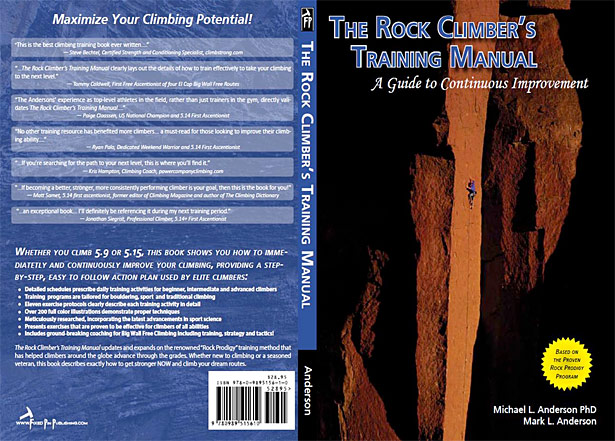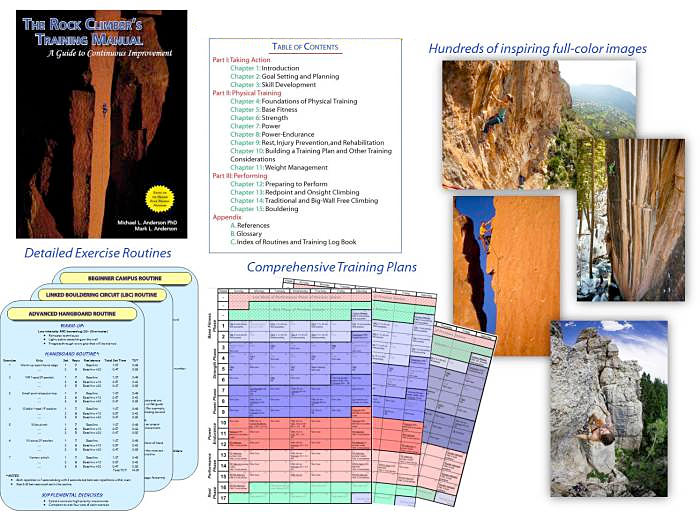The Rock Climber’s Training Manual Review
By now you’ve likely heard of the Rock Climber’s Training Manual, brought to us by Mike and Mark Anderson, two climbers of normal ability who have reached 5.14 through years of dedicated training and hard work. What started as the Rock Prodigy article on RockClimbing.com has morphed into one of the most complete and informative books on climbing training that you can find.
In fact, the size is a little overwhelming. There’s so much in here, from the different workouts to nutrition to injury recovery. It’s best absorbed over a long period of time, and for me has become an invaluable resource that I reference frequently.
The foundation of the program is periodized training in which you focus on a specific area, like endurance, for a length of time, then move onto strength, then power, then power endurance, with the goal of peaking at a certain time when it all comes together. This idea is not new, but they tie it all together in a way that makes it easy to understand and simple to execute, if you can stay on the path.
Over the last nine months, I’ve been following a dedicated training program based on this book, but I’m actually not doing their routine, not exactly. My life is too uneven to commit to peaking at a certain time, and I get stretches where I can climb outside a lot, then times when the gym is my best friend. I think in this case, a more rounded approach makes sense where I can pick and choose what aspects I want/need to train. For me, keeping my fingers strong and healthy is the top priority, so I hangboard at least once per week. I’ve also never been a very powerful climber, so bouldering has been a focus as well. On the days I climb outside, endurance or power endurance is usually the name of the game, so in a given week I’m usually hitting all four areas.
They briefly touch on this approach in their book (non-linear periodization), noting that you wont have peaks as high as with standard periodization, but I’ll take steady growth instead, with the chance to climb outside as much as possible. If you are someone on a more rigid schedule, then this might make more sense for you. (When I have kids, maybe I’ll feel differently.)
Regardless, the workouts and exercises are presented in an easy to follow format and make it very clear that if you are at this level, you do this, if that level, do that. Its’ full of meat and potatoes that other training books were lacking, in terms of what to actually do. Even Training for Climbing, which arguably first presented the periodized training concept in the most concise way, doesn’t match the attention to detail found in the RCTM.
The success stories are hard to ignore, and the results speak for themselves. Personally I’ve seen big gains in my onsight level and hardest bouldering grade, though the current guidebook project means I haven’t spent any time redpointing. Some will say following any kind of structured approach will give better results than random climbing, and while this is true, following the program outlined in the RCTM has the potential to truly elevate your climbing. The question is, can you be disciplined and focused enough to get after it? As I said, for me the answer right now is no, but I’m good with that, and I’ve still seen what I would consider impressive results from doing what I’ve done so far. And if (when?) I reach a point in life where that makes more sense, it appears I have a lot to look forward to.
Retail is $28.95 (worth every penny and then some), available for purchase here. You can also purchase the full kit, which includes the Rock Prodigy hangboard, pulley kit and the RCTM book, from Trango.
Bulldog Creek Dog Walk (IV WI 4+)
Hayden Carpenter and Tom Bohanon recently repeated an obscure ice climb on the south side of Mt Sopris. Given a brief mention in Jack Robert’s ice guide, Bulldog Creek Walk is described as being 100 meters of WI 4. What they found was seven pitches of ice in a remote setting that makes for one […]
Connect with Us

















Recent Comments